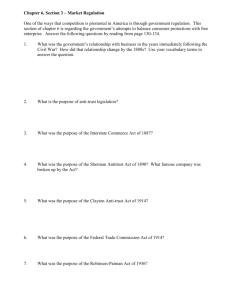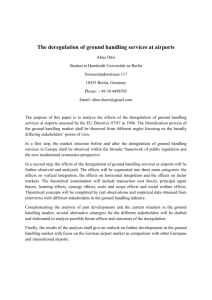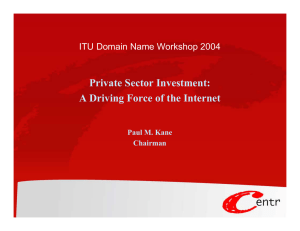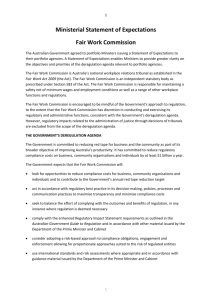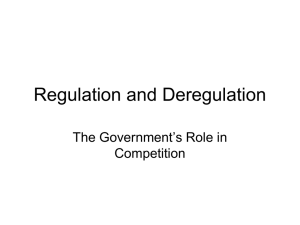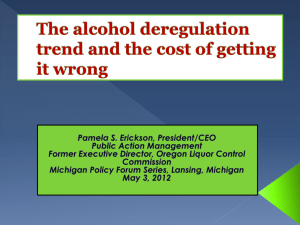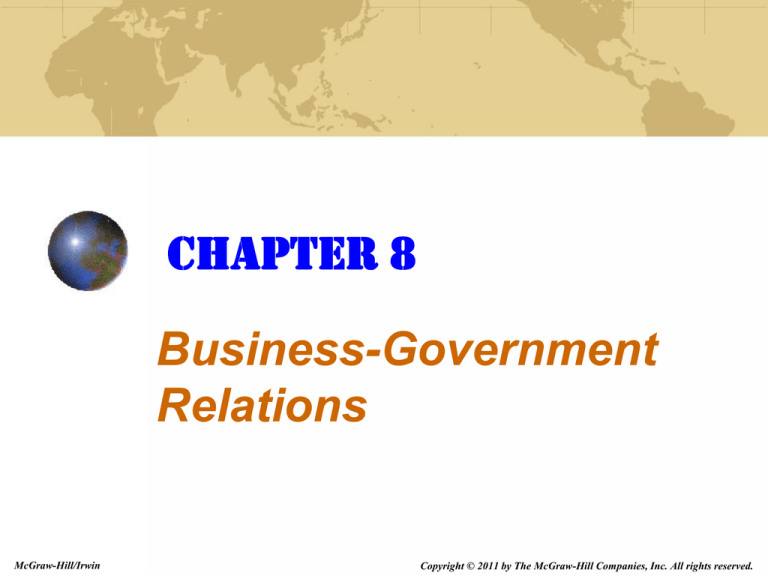
Chapter 8
Business-Government
Relations
McGraw-Hill/Irwin
Copyright © 2011 by The McGraw-Hill Companies, Inc. All rights reserved.
Ch. 8 Key Learning Objectives
Understanding why sometimes governments and business
collaborate and other times work at arm’s length from each
other
Defining public policy and the elements of the public policy
process
Explaining the reasons for regulation
Knowing the major types of government regulation of
business
Identifying the purpose of antitrust laws and the remedies
that may be imposed
Comparing the costs and benefits of regulation for
business and society
Examining the conditions that affect business in a global
context
8-2
How Business and Government Interact
Government cooperates with business for mutually
beneficial goals
Influenced by nation’s values and customs, therefore differs by
county
Government’s goals and business’s objectives are in
conflict
Companies operating globally may find governments
whose legitimacy or right to be in power is questioned
May be faced with dilemma of continuing to do business when
could be supporting the illegitimate power
May choose to become politically active or refuse to conduct
business until legitimate government is in place
8-3
Government’s Public Policy Role
Public policy –
A plan of action undertaken by government officials to
achieve some broad purpose affecting a substantial
segment of a nation’s citizens
Public policy inputs shape a government’s policy decisions
and strategies to address problems
Public policy goals can be broad and high-minded or narrow
and self-serving
Governments use public policy tools involving combinations of
incentives and penalties to prompt citizens to act in ways that
achieve policy goals
Public policy effects are the outcomes arising from government
regulation
8-4
Types of Economic Public Policies
Fiscal policy
Refers to patterns of government taxing and
spending that are intended to stimulate or
support the economy
Monetary policy
Refers to policies that affect the supply, demand,
and value of a nation’s currency
8-5
Types of Economic Public Policies
Taxation policy
Raising or lowering taxes on business or individuals
Industrial policy
Directing economic resources toward the development of
specific industries
Trade policy
Encouraging or discouraging trade with other countries
8-6
Types of Social Public Policies
Advanced industrial nations have developed
elaborate systems of social services for their citizens
Developing economies have improved key areas of
social assistance (health care, education)
Social assistance policies that effect specific
stakeholder groups are discussed in subsequent
chapters
8-7
Government Regulation of Business
Regulation
The action of government to establish rules of
conduct for citizens and organizations. It is a primary
way of accomplishing public policy.
Reasons for regulation
Market failure
Negative externalalities
Natural monopolies
Ethical arguments
8-8
Types of Regulation: Economic
Economic regulations
Aim to modify the normal operation of the free market
and the forces of supply and demand
Includes regulations that
Control prices or wages
Allocate public resources
Establish service territories
Set the number of participants
Ration resources
8-9
Types of Regulation: Social
Social regulations
Aimed at such important social goals as protecting
consumers and the environment and providing workers
with safe and healthy working conditions
Includes regulations which apply to all businesses
Pollution laws
Safety and health laws
Job discrimination laws
And others that only apply to certain businesses
Consumer protection laws for businesses producing and selling
consumer goods
8-10
Figure 8.1
Types of Regulation and
Regulatory Agencies
8-11
Figure 8.2
Spending on U.S. Regulatory Activities
8-12
Figure 8.3
Staffing of U.S. Regulatory Activities
8-13
Continuous Regulatory Reform
Levels of regulatory activity tend to be cyclical and
dependent on politics
Deregulation refers to the scaling down of regulatory
authority
Reregulation is the return to increased regulatory activity
Areas where deregulation has occurred in recent
years
Commercial airlines
Interstate trucking companies
Railroads
Financial institutions
8-14
Regulation in a Global Context
As patterns of international commerce grow more
complicated, governments recognize the need to
establish rules that protect the interests of their own
citizens
International regulation in general occurs when there is a
growth of exiting, yet often conflicting, national
regulations of a product, or the product itself is global in
nature, thus requiring international oversight and control
Sometimes national leaders resist the notion of
international regulation; yet at other times, international
regulation is welcomed or at least accepted as
necessary
8-15

